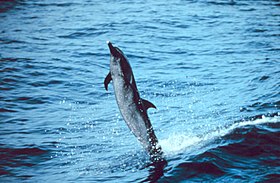Slender dolphin
| Slender dolphin | ||||||||||||
|---|---|---|---|---|---|---|---|---|---|---|---|---|

European dolphins ( Stenella attenuata ) |
||||||||||||
| Systematics | ||||||||||||
|
||||||||||||
| Scientific name | ||||||||||||
| Stenella attenuata | ||||||||||||
| ( Gray , 1846) |
The slender dolphin ( Stenella attenuata ) is a species of dolphin from the genus of the spotted dolphins ( Stenella ), which occurs in the tropical and temperate oceans.
features
The slim dolphin reaches a body length of 1.7 to 2.4 meters and a weight of 90 to 115 kilograms. The young are about 80 to 90 centimeters long at birth. In general, the animals have long and thin snouts. Both the upper and lower parts of this snout are dark in color, with the dark color at the top mostly reaching to the eye. A fine white line forms the lip contour. There are 70 to 96 teeth in the upper jaw and 68 to 94 teeth in the lower jaw. The neck, throat and belly are light gray. The sides of the body are drawn in three colors, with the lower area being light gray and terminated by a gray central stripe. The area above this stripe is noticeably darker gray. The whole body of the trunk has spots that are dark on the light surfaces and light on the dark. Newborns are unspotted, the number of spots increases with age until they can almost hide the basic color. First, the dark spots appear on the stomach. The concave fin, which is quite variable in shape, is dark gray, the fluke handle corresponds to the color of the central stripe. The flippers are small and dark on both sides. The fluke has a slightly concave rear edge, a slight indentation in the middle and pointed ends.
The animals vary greatly in their size and pattern in their habitat, although the forms that live on the coast differ significantly from the pelagic animals. The coastal form is significantly more massive than the ocean form and more spotted. The spotting is individually different in the adult animals, whereby animals from the population in the Gulf of Mexico can be relatively monochrome. In the Atlantic there is often confusion with the rein dolphin , which is also noticeably spotted.
behavior
Slender dolphins form schools of 50 to 1000, occasionally up to 3000 animals. The coastal form usually remains in groups of less than 100 animals. They are very active animals that often make high leaps out of the water. Riding on the bow wave of boats and other "gimmicks" can often be observed, but boats are usually avoided in tuna fishing areas. In the Eastern Pacific, the slender dolphins often accompany schools of tuna, which also makes them a frequent bycatch in the tuna fishery. They do not feed on these large fish, but share their prey with them in the form of smaller pelagic fish. In addition, they mainly feed on octopus , squid and crustaceans .
distribution
The slender dolphin is found worldwide in all tropical and subtropical oceans, especially in the area between the 40th degree south and the 40th degree north latitude. The global population is estimated to be over three million animals, of which around two million live in the Eastern Pacific. This makes this species the second most common species of dolphins after the bottlenose dolphin , although the population was around seven million in the 1950s.
The greatest concentrations of dolphins are found in the shallow and warm water areas. There is also a tendency for collection in areas with strong temperature gradients .
Humans and slender dolphins
Since the slender dolphin is common with tuna, trawling of tuna posed a major threat to these animals. Millions of slender dolphins were caught and killed in the 1960s and 1970s, reducing regional populations by 75% and global populations by 50%. This changed with the international campaigns to stop using tuna that came from such fisheries. Many sales chains switched their sales to "dolphin-friendly tuna". Another step has been the ban on trawling by the United Nations since 1993 .
Taxonomy
The slender dolphin was first described in 1846 by John Gray , under which he also included the bridle dolphin (today Stenella frontalis ).
Two subspecies are described:
- Stenella attenuata attenuata which is pantropically widespread
- Stenella attenuata graffmani , the coastal form off the coast from Mexico to Peru
swell
- Mark Carwardine : Whales and Dolphins . Delius Klasing, Bielefeld 2008, ISBN 978-3-7688-2473-6 , p. 184-185 .
- Stenella attenuata in the endangered Red List species the IUCN 2006. Posted by: Cetacean Specialist Group, 1996. Retrieved on 9 May, 2006.

